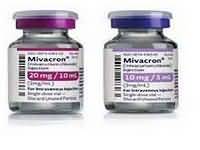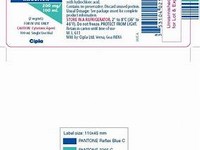Mivacurium

CLINICAL USE
Non-depolarising muscle relaxant of short durationDOSE IN NORMAL RENAL FUNCTION
IV injection: 70–250 micrograms/kg; maintenance 100 micrograms/kg every 15 minutesIV infusion
: maintenance of block 8–10 micrograms/kg/minute, adjusted to maintenance dose of 6–7 micrograms/kg/minute according to responsePHARMACOKINETICS
DOSE IN RENAL IMPAIRMENT
GFR (mL/MIN)
DOSE IN PATIENTS UNDERGOING RENAL REPLACEMENT THERAPIES
IMPORTANT DRUG INTERACTIONS
Potentially hazardous interactions with other drugsADMINISTRATION
Reconstition
_Route
IV bolus,IV infusion
Rate of Administration
IV bolus: Doses of up to 0.15 mg/kg may be administered over 5–15 seconds. Higher doses should be administered over 30 secondsComments
Compatible with sodium chloride 0.9%; glucose 5%; dilute to 500 micrograms/mLCompatible with fentanyl, alfentanil, droperidol and midazolamOTHER INFORMATION
Spontaneous recovery is complete in approximately 15 minutes and is independent of dose administeredIn patients with CKD 5 the clinically effective duration of block produced by 0.15 mg/kg is approximately 1.5 times longer than in patients with normal renal function; hence, dosage should be adjusted according to individual clinical responseResults from a study comparing 20 anephric patients with 20 healthy patients highlight the need for reduced dosages of Mivacron in patients with renal failure: patients with renal failure had a slightly shorter time to maximum depression of T1/T0, a slower recovery of T1/T0 to 5% (15.3 vs 9.8 min), required a slower infusion rate (6.3 vs 10.4 micrograms/kg/min) and experienced slower spontaneous recovery (12.2 vs 7.7 min). The drug company has no specific guidelines as to the extent of dose reduction required.
See how to identify renal failure stages according to GFR calculation
See how to diagnose irreversible renal disease
Home








